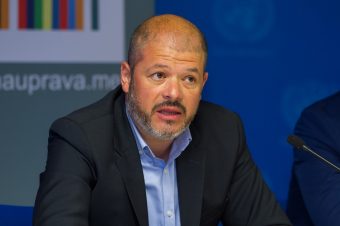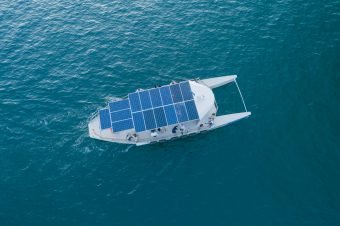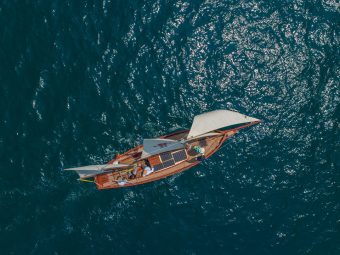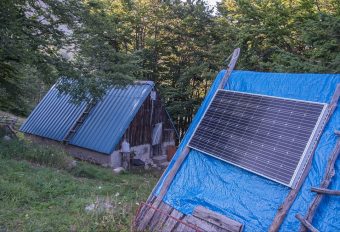If you are a fan of unspoiled nature hidden between the Montenegrin mountains and the Adriatic Sea, surely it must have happened to you, at least once, to be stuck for hours in traffic at the beautiful Bay of Kotor. It seems like such the hustle and bustle could end, especially if you decide to park your cars and use public eco-boats during your vacation. If you take another eco-friendly step and decide to stay in a “green” hotel, you will also have a variety of choices. There are 27 Green Key certified hotels in Montenegro
The owners of electric vehicles will be pleased by the fact that that UNDP has supported the installation of 11 chargers in Podgorica so far. We talked about the progress in the field of ecology, as well as the other innovative and sustainable projects to Mr Tomica Paovic, Democratic Governance & Economy and Environment Team Leader at UNDP.
EP: You have organised a network of eco-friendly hotels in Montenegro. How does a hotel get a Green Key certificate? What motivates hotel managers to enter a process of obtaining this document?

Tomica Paovic: Montenegro currently has 27 certified hotels, and their number is constantly increasing. Doing business following the principles of environmental protection, rational use of resources, that is water and electricity, while continually improving the quality of offers – are prerequisites for obtaining the Green Key. Certified hotels are energy efficient; they use renewable energy, implement measures for the reduction of waste that hotel produces, have a responsible attitude to employees and the local community and are less harmful to the environment.
Due to all this, eco-certified hotels have lower operating costs, can operate throughout the year, and since they are competitive, they position more easily in the markets of Western and Northern Europe. Eco-conscious tourists expect a high quality of service and full experience, which is the reason why they are ready to spend more money to stay in a certified accommodation.
EP: Environmentally conscious tourists are attracted to the destinations that offer a stay in unspoiled nature and enjoy the wild beauty, which is exactly the thing distinguishes Montenegro. How many municipalities have participated in the UNDP’s “Low Carbon Tourism” program so far?
Tomica Paovic: Sustainable or “green” tourism in Montenegro has a great potential due to its relatively untouched nature and preserved cultural heritage. UNDP, in cooperation with numerous partners, successfully implemented 31 investment projects in 12 Montenegrin cities: Podgorica, Cetinje, Kolasin, Mojkovac, Savnik, Pluzine, Zabljak, Pljevlja, Budva, Tivat, Herceg Novi and Ulcinj.
These are very diverse projects, from supporting ecological water transport in the Bay of Kotor, through investing in the development and equipment of bicycle and pedestrian paths, the installation of solar water heating systems at hotels, the replacement of conventional public lightening with LED bulbs and the procurement of electric vehicles, to the introduction of modern, automated and highly energy-efficient heating and cooling systems. All projects have significantly contributed to the promotion and diversification of Montenegro’s touristic offer.
EP: What kind of program did you implement in these municipalities?
Tomica Paovic: In addition to the savings of 60 per cent on electricity bills, the modernisation of public lightning in Zabljak and Savnik achieved better illumination, increased safety of traffic participants and eliminated light pollution. Since last year, electric vehicles for the local transport of tourists have been available to visitors of Cetinje, Ulcinj and Zabljak and there are more and more electric vehicles inside hotel complexes.
Forty households in katuns (shepherds’ temporary summer house in the mountains) in Pluzine and Zabljak got access to electricity for the first time when solar power systems were installed in their households. Solar panels will contribute to creating better working and profit conditions for the farmers and shepherds who take their livestock to the katuns. In addition to the traditional role the katuns play, the tourists like to visit Montenegrin katuns, thus they are becoming an important part of the tourist offer of the northern part of the country.
This project has encouraged both the public and the private sector to implement concrete measures and introduce new technologies, contributing to the fight against climate change. The regulation dealing with carbon dioxide (CO2) reduction has been improved, and the framework was established for sustainable mechanisms of financing. I am here primarily referring to the Eco Fund, as support for innovative initiatives with a green background. With our partners, we have managed to raise over 13 million euros in investments in sustainable tourism, and a little bit more than 30 new “green” jobs have been created on the territory of these municipalities.
In focus:

EP: Last summer, electric and hybrid ships started operating as part of the “Bella Boka” project on the route from Kotor to Herceg Novi. The company “Bella Boka” has announced that it will expand its fleet this year. To what extent has UNDP helped in the development of this project and will you continue to support this project?
Tomica Paovic: The project “Bella Boka” is of significant importance for the Bay of Kotor and Montenegro. It establishes sustainable water transport with electric and hybrid trimaran sailboats through the Bay of Kotor. That will have a positive effect on solving the problem of congestion in road transport, especially during the summer season, when you need an hour and a half or two hours at its best from Kotor to Herceg Novi due to traffic jams. From a cultural point of view, this project is important because it revives the tradition of using waterways for the transport of residents and tourists – which was forgotten in the past decades. Electric and hybrid trimaran sailboats, designed for short-distance tourist trips, are ideal for coastal cruising and interurban transport in coastal cities.
This project will reduce the emission of harmful gasses in traffic and offer visitors an exciting eco-friendly travel experience. More than 4 million euros have been invested in this unique project at the Adriatic, while co-funding through UNDP was 150.000 euros. The Investor has announced that this year another 9 such sailboats will be providing the service of public transport at sea.

UNDP has supported the reconstruction of the 100-year-old-ship, which rock musician and environmental activist Antonije Pusic, also known as Rambo Amadeus, turned into a solar sailboat. With a sophisticated design, this sailboat is powered by solar energy, without CO2 emission, exhaust gases and noise. This venture combines the local nautical tradition with sustainable materials and clean technologies, and it is an example of how innovations in design, renewable energy and the private equity investment for the public good, combine economic opportunity with the need for environmental protection.
EP: Electromobility is on the rise in the Scandinavian countries and in the Balkans, it has just started developing. What is the role of UNDP Montenegro in the development of this sector?
Tomica Paovic: The increasing global awareness of climate change has led the automotive industry, which contributes significantly to environmental degradation, to put in great efforts in resolving this issue. One of the most important moves is the production of more environmentally-friendly vehicles. It is true that European countries, such as Norway and Sweden, advanced most in terms of electrification of the traffic. However, the road to full e-mobility, not only in Montenegro but also globally, is undoubtedly a long one, taking into account many challenges, which are primarily related to the inadequate offer of electric vehicles and the long period from ordering to delivery, then underdeveloped charging infrastructure, the absence of various incentives such as financial, economic and regulatory for e-vehicle owners. In order to make transport truly sustainable globally, society, as a whole, needs to re-examine the entire mobility system and to find innovative ways for the reduction of our dependency on vehicles. Here, I primarily refer to the implementation of the car-sharing model, development of better public transport infrastructure and greater use of low-emission or zero-emission transportation.
Alternative solutions that contribute to the sustainability of transportation are necessary, and the introduction of electric vehicles is just one of those. We have also helped the equipment of more than 70 km of hiking and biking trails throughout Montenegro, as well as the introduction of environmentally-friendly vehicles for the transportation of tourists in protected areas and touristic complexes.
EP: UNDP in Serbia mostly develops projects for the utilisation of biomass. Which type of the renewable source in principle has UNDP decided to support in Montenegro?

Tomica Paovic: Renewable energy sources are one of the key tools for the reduction of greenhouse gas emissions. There is significant untapped potential in the field of renewable energy sources, especially in the field of solar energy, and more importantly in the sector of small producers, such as small and medium-sized enterprises, as well as individual households.
This year could be a significant milestone in the global effort for the reduction of greenhouse gas emissions in the energy sector. Namely, the signatory countries of the Paris Agreement, which are now updating their Nationally Determined Contributions (NDCs), could raise their previously targeted ambitious by increasing the production of electricity from renewable sources.
The decarbonisation of the electric power system itself is not enough to meet climate goals set out in this Agreement. Instead, the entire energy sector must undergo a profound transformation by moving to renewable sources and adopting energy efficiency measures, as well as increasing the level of electrification of end-users. In this context, part of our focus is to improve the investment and development environment for the installation of solar panels, especially for small and medium-sized enterprises and households.
Interview by: Nevena Djukic
Read the whole interview in the new issue of the Energy portal Magazine NATURAL RESOURCES, march – may, 2020



